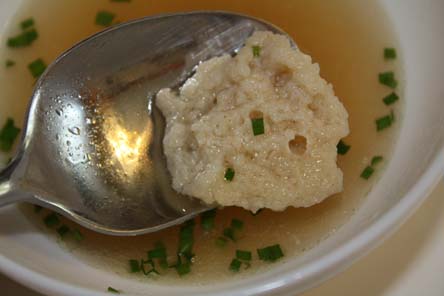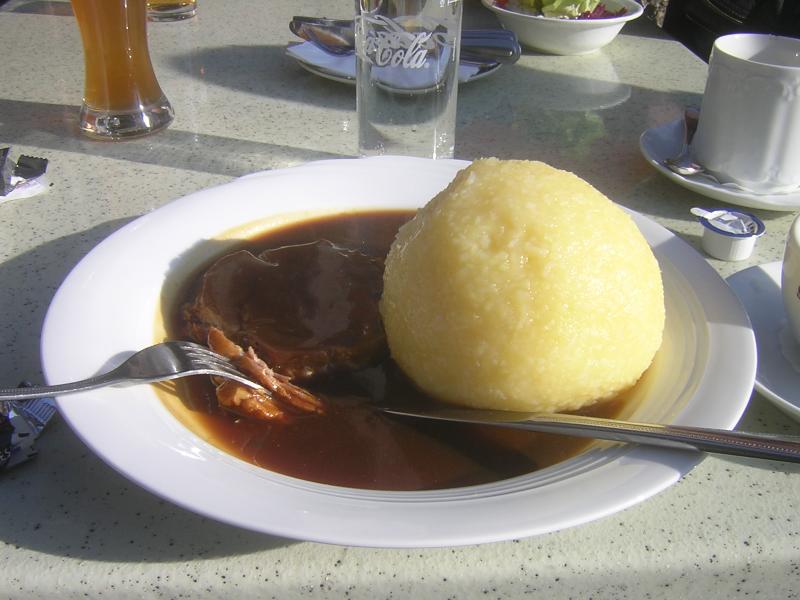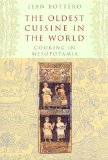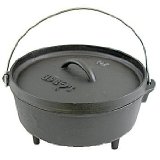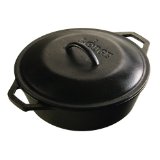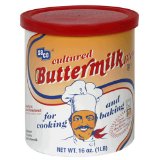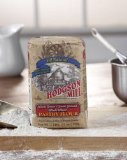|
Recipes
A man may build a complicated piece of mechanism, or pilot a steamboat, but not more than five out of ten know how the apple got into the dumpling. ....
Edward A. Boyden
From Chicken and Dumplings to Pot Stickers!
Dumplings are so diverse they are more of a technique or a style
of cooking
than a dish. Anything that fits inside dumpling dough, or whatever can be broken up to blend with a batter, can be a part of the world of dumplings. .
This is a start on this project. There is so much you could probably spend a lifetime studying dumplings! Look for more interesting info, in fact join the Food History Newsletter
Where does the word Dumpling come from?
According to my favorite food history authority Alan Davidson,
"Dumpling. A term of uncertain origin which first appeared in print at the beginning of the 17th century, although the object it denotes--a small and usually globular mass of boiled or steamed dough--no doubt existed long before that.
One authority says that the word dumpling goes back to 1600 in the United Kingdom in the Norfolk area.
dumpling c.1600, Norfolk dial., of uncertain origin, perhaps from some Low German word or from obsolete noun dump "lump." Related: Dumplings.
from the Online Etymology Dictionary
"Just like Yorkshire pudding, Norfolk dumplings were intended to fill hungry stomachs cheaply so that the paucity of the meat course was less noticeable. Unlike Yorkshire puddings , however, they have always been served with that meat, rather than before it."
Food legends of Britain |
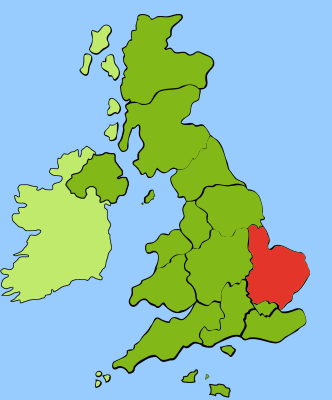 |
I think personally that the OED is right when it says perhaps from some low German word, because dampf is a German word for steam, there is a German dumpling dish called Dampfnudel.
Don't you agree that dampf-ling could easily become dumpling?
What is a dumpling?
You could say a dumpling refers to a portion of dough or batter that is usually steamed or boiled.
However it can also be fried or baked.
It can be a batter or dough rolled out that is cooked by itself or
filled with anything from meat to fruit.
It can be a main dish, side dish or dessert.
Again from my favorite food historian:
Alan Davidson
Was first created to extend meat
A dumpling is a food with few, indeed no, social pretensions, and of such simplicity that it may plausibly be supposed to have evolved independently in the peasant cuisines of various parts of Europe and probably in other parts of the world too. Such cuisines feature soups and stews, in which vegetables may be enhanced by a little meat. Dumplings, added to the soup or stew, are still, as they were centuries ago, a simple and economical way of extending such dishes.
The Base of the Dumpling was based on the local grains
The dough for most dumplings has always been based either on cereal, whichever was the staple in a given region (oats, wheat, maize, etc.), or on one of vegetables from which bread dough can be made...(potato, pulses, etc.)...However, despite its simplicity, the humble dumpling, or anyway the range of foods to which the name is applied, has evolved in the course of time from the prototypes into something more complex.
Dumplings Evolve from their humble beginings
A first step was provided by the filled dumpling, in which the dough encloses something else, for example apple in an apple dumpling, and a sour cooking plum (its stone replaced by a lump of sugar) in the Austrian and Czech Zwetschkenknodel...[in] Europe, it would be fair to say that dumplings are almost ubiquitous in that continent, but by no means of equal importance in the various countries.
More popular in colder climates
They are more popular in colder climates...there are three regions in which they have flourished most: England...the much larger area of C. Europe (including Bavaria, Austria, Bohemia)...and the specialized habitat provided by Italy for gnocchi."
---Oxford Companion to Food, Alan Davidson [Oxford University Press:Oxford] 2nd edition, 2006 (p. 261)
~~~~~~~~~~~~~~~~~~~~~~~~~~~~~~~~~~~~~~~~~~~~~~
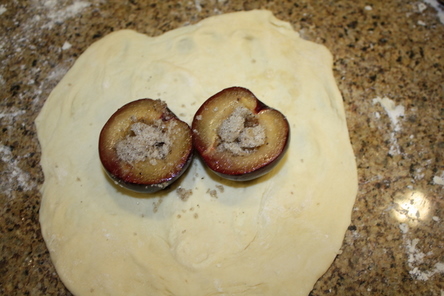
Here is an example of a plum dumpling that replaces
the pit of the plum with sugar.
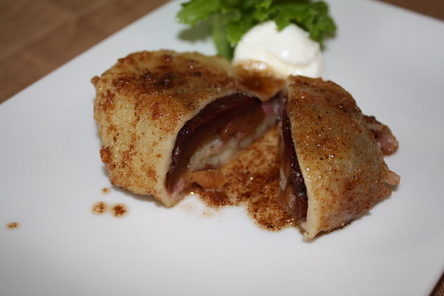
~~~~~~~~~~~~~~~~~~~~~~~~~~~~~~~~~~~~~~~~~~~~~~~~~~~
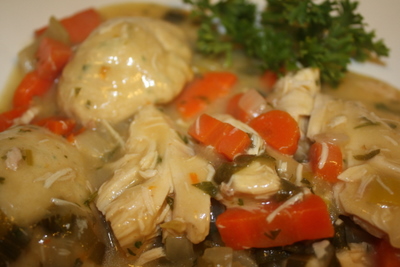
A favorite dumpling dish in the states is Chicken and Dumplings
There are lots and lots of dumpling dishes in the states but maybe this got
it's popularity from a folk song that was popular , "She'll Be Comin' Around the Mountain"
Also chicken was a typical special sunday dinner meal in the United States.
This was also a great way to cook a bread like dish in a one pot meal.
Either in a cast iron pot which could hang sit in a fire, hang over a fireplace,
or sit on a woodstove.
~~~~~~~~~~~~~~~~~~~~~~~~~~~~~~~~~~~~~~~~~~~~~~~~~~~
When did this style of cooking start?
 |
Ancient Rome had their own dumplings and can be read about in the oldest of cook books by Apicius.
Here is a recipe translated of course into English. They didn't call them dumplings in Ancient Rome., the translator used the word but he could have course used a word like Knödel or Gnochi.
Plain Dumplings with Broth [Isicium Simplex]
To 1 acetabulum of stock add 7 of water, a little green celery, a little spoonful of ground pepper, and boil this with the sausage meat of dumplings. If you intend taking this to move the bowels the sediment salts of hydrogarum have to be added."
---Cookery and Dining in Imperial Rome, Apicius, edited and translated by Joserphy Dommers Vehling [Dover:New York] 1977(p. 65-66) |
| Another Ancient Dumpling:
Jiaozi (JOW-zah) a Chinese dumpling, is a traditional Chinese food—one of the most widely loved foods in northern China In ancient times. jiaozi, whose shape looks like a horn, was called 'Tiao" (literally "horn"). It was also called "bianshi" (literally "flat food") due to its flat shape The name "jiaozi" derives flora the ancient time-counting method in China When the Chinese people eat dumplings stuffed with meat and vegetables at the junction of the end of the old year and the beginning of the New Year, it is right between eleven pm and one am. Since this period is called jiaozi (??) in Chinese, the dumplings people eat during this time are named after it. The Story of Chinese Dumplings
The history of Pot Stickers In Japan a similar dumpling is called Gyoza.
|
Pot Stickers. They are the same dumpling but fried on one side. possibly one day the steam ran out of the pan and the cooked to the bottom of the pan.
|
Pictures of Various kinds of dumplings. (some with recipes)
Different Ethnic Dumplings
The Future of Dumplings
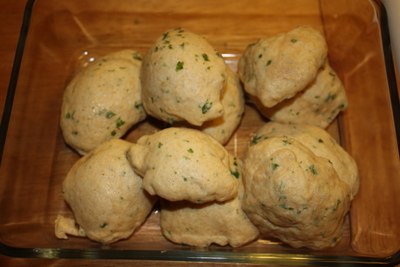
The reputation of dumplings related to healthy food is not promising.
People tend to think dumplings as starchy, fattening also heavy, they certainly
can be. Historically a meat with dumplings and gravy
were a stick-to-your-ribs meal to stay with you working the farm all day or
other heavy laborious tasks in the pre-computer days.
Above are dumplingsI made that are part white flour and part white whole
wheat pastry flour. The extra fiber makes them much more diet friendly as well as
having more nutrients. You can take any dumpling recipe and just substitute
half of the white flour with white whole wheat pastry flour.
Instead of serving them with a thick gooey gravy you can use a nice broth.
The Pot Sticker type dumpling if it is filled with vegetables, and simmered in
broth with vegetables, is a pretty good choice for a healthy low fat, but very tasty
meal.
|


